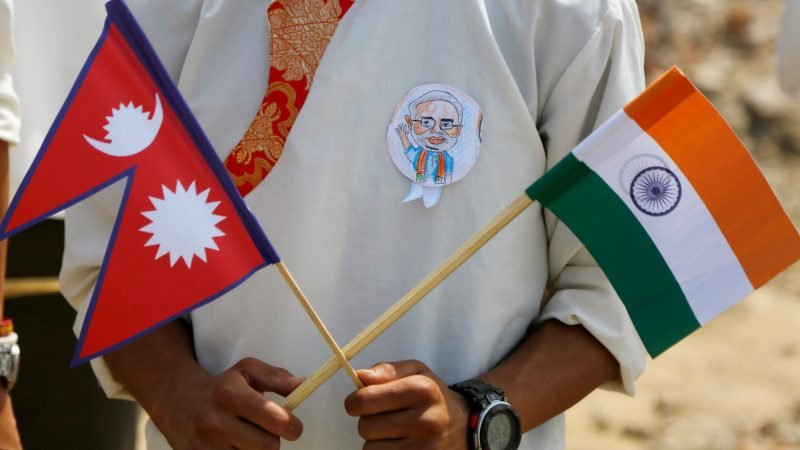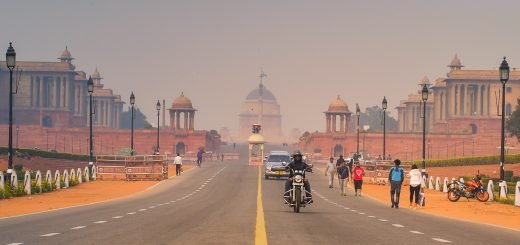Deep-rooted friendship: But relation with highs and lows

India and Nepal, the two states are more than just neighbours; the relationship is “unique”. Both are an integral part of the Indian sub-continent and mark their unique identity in the world. Both the countries have their unique geography, history and cultural heritage, but are bound together through historical, religious, social, cultural, economic similarities and political relations. Rooted people-to-people relations, informal closeness and formal diplomatic relations have equal importance in India-Nepal relations.
Religion is perhaps the most important factor and plays a predominant role in shaping the cultural relations between these two states. Both have made great contribution enriching religion and cultural heritage in this region and beyond. To Samrat Ashoka’s relation with the monastery of Chabahil-Kathmandu founded by his daughter Charumati to Lord Buddha, born in Nepal, has left his footprints not only in South Asia but all over the world. Every year a large number of people from both the sides visit each other’s states for pilgrimage. Not only religious and cultural relations, but the lingual affinities through common and shared languages includes, inter alia, Hindi, Nepali, Maithili, Bhojpuri, etc rooted in Sanskrit. Devanagari scripts in writing are the factors of proximity. Moreover, the relation can be defined as “Roti-Beti Ka Sambandh“.
The unique security force of India, The Gurkha Regiment, known as bravest in the world, pillar of India’s security for decades, comprises of the soldiers from Nepal.
Sam Manekshaw, India’s first field Marshall, who himself belonged to the eighth Gurkha Rifles regiment, once famously said, “If anyone tells you he is never afraid, he is a liar or he is a Gurkha.”
The close cultural relationship between the peoples of India and Nepal is a great asset for both states. This closeness has not only helped maintain traditional friendly relations but has also greatly contributed to promoting mutual understanding, appreciating each other’s aspirations, and cementing the existing ties of a warm and cooperative neighbourhood. This has remained and will continue to remain, the strongest and an unshakable link between these two states.

How India and Nepal view India-Nepal relations?
Regarding the India-Nepal relations, both states share a historical and deep-rooted friendship. Formally, India and Nepal initiated their relationship with the 1950 Indo-Nepal Treaty of Peace and Friendship and accompanying supplementary letters that defined security relations between the two states, and an agreement governing both bilateral trade and trade transit via Indian Territory.
For India, Nepal is not only a friendly neighbourhood state who shares a border of over 1,850 km with five of its states but rather has a more significance in terms of security and economy. When coming to power in 2014, Prime Minister Narendra Modi declared ‘Neighbourhood First’ policy so the relationships with the neighbours can be strengthened, in which Nepal was an essential part of the policy. India assisted Nepal during Earthquake of 2015, where the Indian Government quickly dispatched its National Disaster Response Teams and special aircraft with rescue and relief materials to Nepal. Both states’ cooperation in water resources primarily concerning the common rivers is one of the most important areas of bilateral relations. The management of flood, inundation and hydropower has been working well. There is numerous project on which both the states are working on- Educational Development Projects in Nepal, Power and New Partnership in Agriculture.
India sees Nepal as a state that has been moving through a process of peaceful transition, making impressive strides in several areas: ending monarchy, adopting secularism, promoting social inclusion, and achieving development.
Similarly, Nepal is landlocked by India from three sides with an open border. India has provided transit for all the goods coming from the Bay of Bengal to Nepal in accordance to the international law. India is Nepal’s most important trading partner accounting more than 58% of all imports and 36% of exports. Also, many Nepalese workers work in India, which becomes a major source of remittance to Nepal. Besides India is also an important development partner for Nepal.
Likewise, Nepal’s geo-strategic importance is articulated by a good Nepal-India friendship, which links India to Nepal’s security concern. Especially after the independence of India in 1947, Nepal-India political relations can be characterised by India’s influence on Nepalese politics which have created ups and downs in the relations. Regarding long history, comprehensive Nepal-India friendship is important to Nepal concerning regional cooperation, economy, trade, development, and security. For Nepal, bilateral relations with India have witnessed friendship, doubt, trust, concealed antagonism, open distrust, helplessness, mutual appreciation, etc. Hence, geographically, historically and culturally, Nepal-India relations is important for Nepal.

But every relation has some disputes!
History has shown many ups and downs in the relation, and the two recent disputes because of which the relations of both the countries hit rock-bottom are 2015 unofficial economic embargo and the burning border dispute.
Nepal promulgated its new Constitution in 2015 but the Madhesh-based political parties went on strike to put pressure on addressing their grievances. The riots near the Indo-Nepal open border was certainly a security concern for India, however, Nepal believes that the economic embargo by India during that period was due to their vested concerns in the Constitution of Nepal. The Indian government wanted Nepal’s constituent assembly to make necessary amendments concerning the “Madhesh issues, electoral constituencies based on population, geography and special characteristics”, later the rejection of the request of India by Nepal turned the situation hostile for both states.
Nepal believes India that created the blockade. However, the Indian Government denied all allegations of any involvement in the blockade and stated the supply shortages were caused by the Nepalese people at the border points. And Former Indian Minister of External Affairs Sushma Swaraj mentioned in the Indian Parliament “India respects Nepal’s sovereignty and wants to see the neighbouring country resolve the present crisis. We are moving towards a solution through talks between Madhesis people and Nepal government so that people of Nepal who are suffering due to the crisis of commodities also get relief .”
The fundamentals of the Nepal-India relations felt friction a few weeks ago in the border dispute in the area of Lipulekh, Kalapani and Limpiyadhura. Nepal claims the area under the 1816 Sugauli Treaty between Nepal and British East India Company, which states the boundary to be Kali river, and Nepal states the origin of the Kali river at Limpiyadhura, also and refers to the maps issued by the British Surveyor General of India in 1827 and 1856.
India also claims river Pankhagad, to the south of Kalapani which is in Pithoragarh, Uttarakhand to be the true border and presents the tax records and administrative and historical documents. India states that the territory has been ineffective possession of India for at least sixty years and even built infrastructure there before, besides this also conducted administration and deploying military forces up to the border pass with China.
The dispute intensified more when Government of Nepal released a new political and administrative map comprising all the disputed areas, to which, New Delhi answered as “unjustified cartographic assertion” and an “artificial enlargement of territorial claims”. Since then there has been a race over the historical and cartographic evidence which both sides assert to be precise, and along which few words war and suspicions have been expressed by both the parties.

China’s influence in India Nepal relations
In friendly and cordial Nepal-India relation, China has been considered as a factor of influence. India accuses China on creating a diplomatic shift for Nepal towards her and has attributed China’s role in the disputes because of the sour India-China relations in the borders. Ties between Nepal and China have been on the upswing, particularly when it comes to trade, investment and regional connectivity with which India has no problem with it, of which the country is accused of.
For Nepal, Chinese engagement is focused, and security-oriented. China’s interest in Nepal has been twofold; first, for security issues in curbing anti-Chinese activities, and secondly, economic and strategic, as Nepal is considered to be a “gateway to South Asia”. Other than the Chinese interest, Nepalese leaders have been accused of playing “China Card” against India whenever there has been a dispute between the two states. China has surpassed India in terms of investments in Nepal as well, where Nepal’s southern neighbour used to be at the top.
India’s reluctance to join BRI and Nepal’s desire for development and growth is also a significant factor of Chinese influence in Nepal-India relations. Although Nepal-India shares geographical, cultural, religious and historical proximity, China’s influence in the relationship increases as more as the disputes between the two states increase. Ideally, Nepal considers China’s influence as null in the Nepal-India relationship, but Nepal’s economic drive, Nepal-India and India-China disputes have led, maybe not significantly in a political way, but economically and through Chinese soft power, there has been an influence in Nepal-India relationship. Depletion of trust between Nepal-India has created a vacuum for China to influence in the relationship.
India believes that China plays a role in India and Nepal relations as the amid a stand-off between India and China on the border. China has been establishing relations within the landlocked country which is interlinked with China’s Belt and Road Initiative in Nepal.
The main reason for India not joining the Belt and Road Initiative was the China-Pakistan Economic Corridor (CPEC), which passes through Pakistan-Occupied Kashmir. Sovereignty and territorial integrity issues, security are the main reasons.
Conflict is inevitable, but combat is optional. –Max Lucado

Hence, Diplomacy is the only way forward for strong Nepal-India relations
The only substantial move for Nepal and India to settle the disputes they have been through bilateral diplomatic talks at different levels conducive to the present environment. In 2014 after the visit of Prime Minister Narendra Modi to Nepal both the countries agreed upon a discussion of the issue through Foreign Secretary-level talk but reports are that both the countries brushed off the issue under the carpet. Thence, high-level political meetings between the two states can lead towards a permanent and final conclusion. It is important to balance principles with reality in an amicable and reverential way.
Deploying thousands of soldiers and war on the border is not the solution in India-Nepal dispute, diplomacy is that will work in resolving the disputes and improving relations. Both the countries need to repair, revise their foreign policy and diplomacy towards each other to improve their bilateral relationship as both countries are a part of SAARC also. Moreover, there has been an erosion of trust between the two states at top-to-bottom. Hence, building trust is important at the high-level and among the people of both the states to enhance the Nepal-India relation. So both sides necessitate a lot of magnanimity, generosity, and foresight.
The unique security relations, investment in upgrading cross-border infrastructure and economic assistance: there are now new rail and road links, an electronic cargo system for Nepali goods to transit and a new cross-border pipeline for petroleum products. These are just some examples of the many achievements of India and Nepal relations. Unfortunately, these silent successes are being ignored. The resources should be focused on political engineering. India and Nepal need to work hard to keep their relationship stable, even if not special.
Additionally, The Nepal-India dispute and China factor in the relationship can be taken into a big picture of trilateral cooperation instead of disputes among the states and scepticism of China’s influence in the relation. The trilateral partnership between three states will be in the interest of the region and will be mutually advantageous in the area of trade, business, infrastructure development and investment. Although the idea of a trilateral partnership depends upon political and strategic relations between three states, the partnership can be a total solution of the disputes, for the development of Nepal, and India-China relations can extend to a strategic and political level in creating a new Asian order. In this Asian century, India-Nepal-China’s geographical proximity, common agendas for development and their involvement in different international and regional forums has opened several possibilities for trilateralism. Hence, this could be also a way forward for Nepal-India relation and beyond.



















